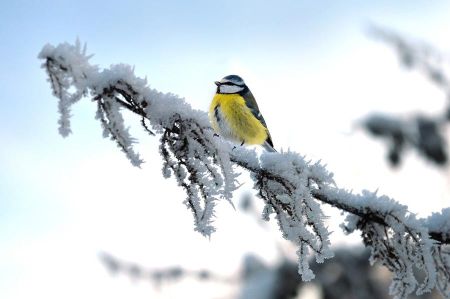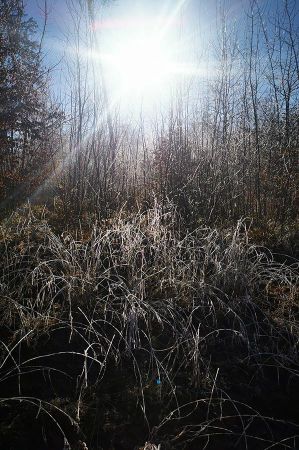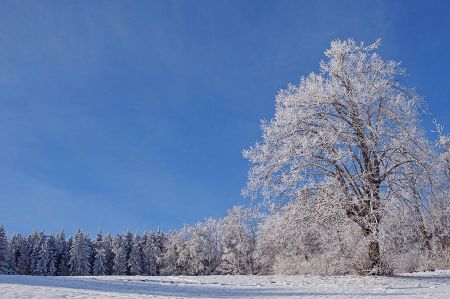Hoarfrost and/or frost - wonderful impressions on the Finne
- Written by Portal Editor
The sun was shining due to the cloudless sky and the bitter cold, and in some places there were still wafts of fog drifting in the light wind on the Finne in Burgenland county, so dress warmly and get out there.
And what fantastic landscapes we were to encounter once again.
 We were coming from Billroda on the Finne hiking trail towards Eckartsberga when the term hoarfrost was mentioned several times, which is not familiar to everyone, especially since the term frost also exists. This also led to a topic that was brought up again and again during the hike due to the magical landscape, because what is the difference and how do hoarfrost and frost actually come about, which can enchant our world so much.
We were coming from Billroda on the Finne hiking trail towards Eckartsberga when the term hoarfrost was mentioned several times, which is not familiar to everyone, especially since the term frost also exists. This also led to a topic that was brought up again and again during the hike due to the magical landscape, because what is the difference and how do hoarfrost and frost actually come about, which can enchant our world so much.
Let's start with the phenomenon of frost, which is easy to explain, because frost is actually just a white precipitation that occurs when water vapor crystallizes directly into ice.
How do frost and hoarfrost actually come about?
 This often forms close to the ground and preferably on car windshields, which is always a nuisance to its users. Hoarfrost, on the other hand, forms when fog or moist air hits very cold surfaces and freezes there to form ice crystals, which leads to a rough, often hairy structure.
This often forms close to the ground and preferably on car windshields, which is always a nuisance to its users. Hoarfrost, on the other hand, forms when fog or moist air hits very cold surfaces and freezes there to form ice crystals, which leads to a rough, often hairy structure.
Hoarfrost is therefore formed from fine, supercooled drops of fog when they settle on solid surfaces whose temperature is below 0 degrees. Ice crystals form immediately and the ice continues to grow as more and more water vapor freezes. Hoarfrost forms primarily where there is a lot of moving fog. Fog is therefore a prerequisite for hoarfrost, but frost does not need fog.
Hoarfrost is formed by what is known as resublimation. This means that the gaseous water vapor changes directly into the solid state and is deposited on objects or on the snow. For this to happen, the temperature should be below -8 °C, the humidity should be high and there should be little wind.
Hoarfrost and the importance of the wind
 Hoarfrost is a solid precipitation that forms from supercooled water droplets from light mist or directly from the water vapor contained in the air through resublimation. In thermodynamics, resublimation refers to the immediate transition of a substance from the gaseous to the solid state. This requires a very high relative humidity of over 90% and an air temperature of below −8 °C. The heat generated is released into the surrounding air through convection, so wind increases the formation of hoarfrost. The wind must not be too strong, however, as it would otherwise destroy the sensitive structures.
Hoarfrost is a solid precipitation that forms from supercooled water droplets from light mist or directly from the water vapor contained in the air through resublimation. In thermodynamics, resublimation refers to the immediate transition of a substance from the gaseous to the solid state. This requires a very high relative humidity of over 90% and an air temperature of below −8 °C. The heat generated is released into the surrounding air through convection, so wind increases the formation of hoarfrost. The wind must not be too strong, however, as it would otherwise destroy the sensitive structures.
Especially against the direction of the wind, needle-shaped ice crystals form in the form of six-rayed dendrites, which can reach a considerable size and bizarre shapes and usually only grow slowly. Hoarfrost grows against the wind because the air coming in from the windward side has a higher degree of moisture than in the lee.
 If the relevant conditions persist for a long time, the hoarfrost can grow into ice feathers that can be up to 5 cm or longer.
If the relevant conditions persist for a long time, the hoarfrost can grow into ice feathers that can be up to 5 cm or longer.
Hoarfrost is relatively rare and is often confused with frost or hoar ice, for which it represents a kind of intermediate stage. A special form of hoarfrost is frost flowers, which used to be seen on the poorly insulated window panes of older houses.
Damage to the forest or individual trees is often caused by the weight of the frozen water alone. Damage to entire frozen trees caused by hoarfrost is not uncommon. This type of tree damage is known in forestry as scent breakage.
 We had discussed the topic of hoarfrost sufficiently, enjoyed the forest with its frozen leaves and the associated noises while hiking, and set off on the way back past the remains of the old railway viaduct, especially as the cold in the shade was noticeably increasing. A wonderful day in nature that we hope will stay with us for a long time to come.
We had discussed the topic of hoarfrost sufficiently, enjoyed the forest with its frozen leaves and the associated noises while hiking, and set off on the way back past the remains of the old railway viaduct, especially as the cold in the shade was noticeably increasing. A wonderful day in nature that we hope will stay with us for a long time to come.
Please read as well:
Gümüşlük - beautiful Bay and Rabbit Island
Camping Club Serbia - Danube-Meeting Smederevo
-
 Hiking Finne at cold temperatures
Hiking Finne at cold temperatures
Hiking Finne at cold temperatures
Hiking Finne at cold temperatures
-
 Hiking Finne at cold temperatures
Hiking Finne at cold temperatures
Hiking Finne at cold temperatures
Hiking Finne at cold temperatures
-
 Hiking Finne at cold temperatures
Hiking Finne at cold temperatures
Hiking Finne at cold temperatures
Hiking Finne at cold temperatures
-
 Hiking Finne at cold temperatures
Hiking Finne at cold temperatures
Hiking Finne at cold temperatures
Hiking Finne at cold temperatures
-
 Hiking Finne at cold temperatures
Hiking Finne at cold temperatures
Hiking Finne at cold temperatures
Hiking Finne at cold temperatures
-
 Hiking Finne at cold temperatures
Hiking Finne at cold temperatures
Hiking Finne at cold temperatures
Hiking Finne at cold temperatures
-
 Hiking Finne at cold temperatures
Hiking Finne at cold temperatures
Hiking Finne at cold temperatures
Hiking Finne at cold temperatures
-
 Hiking Finne at cold temperatures
Hiking Finne at cold temperatures
Hiking Finne at cold temperatures
Hiking Finne at cold temperatures
-
 Hiking Finne at cold temperatures
Hiking Finne at cold temperatures
Hiking Finne at cold temperatures
Hiking Finne at cold temperatures
-
 Hiking Finne at cold temperatures
Hiking Finne at cold temperatures
Hiking Finne at cold temperatures
Hiking Finne at cold temperatures
-
 Hiking Finne at cold temperatures
Hiking Finne at cold temperatures
Hiking Finne at cold temperatures
Hiking Finne at cold temperatures
-
 Hiking Finne at cold temperatures
Hiking Finne at cold temperatures
Hiking Finne at cold temperatures
Hiking Finne at cold temperatures
https://www.alaturka.info/en/hiking-tours/6849-hoarfrost-and-or-frost-wonderful-impressions-on-the-finne#sigProId8d676a9bf6

